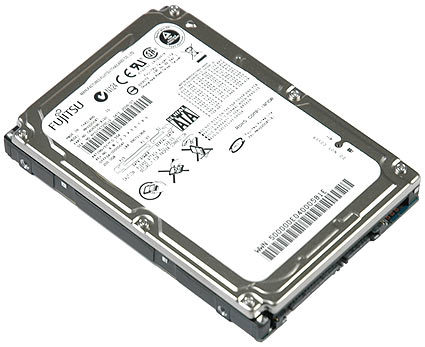200 GB, 2.5", SATA: Fujitsu's MHV2200BT
200 GB On A 2.5" Drive
There hasn't been any significant news in the mobile hard drive area since the introduction of 160 GB models and perpendicular recording. Improvements in technology have stagnated over the past year, and unless there is a significant innovation (new technology), mobile hard drive sizes and performance won't change substantially.
Although there has been a steady rate of innovations and performance gains for other components, storage seems to have fallen behind. One of the reasons for this is that while most computer components are purely dependent on transistors and non-moving electrical parts, hard drives utilize rotating platters in order to extract magnetic data. This mechanical element results in a performance bottleneck that cannot be overcome due to physical limitations. One solution to this problem is solid state hard disks, which have overcome this issue by use of transistor-based flash memory. However, these drives are too expensive for wide-scale use, and they are not practical for high-capacity storage purposes. For a look at what solid state hard disks have to offer take a look at our review of Samsung's 32 GB Flash Drive.
Hard Drives Today And Tomorrow
Other solutions involve use of large flash memory buffers in conjunction with the current hard drive technology, thus resulting in the creation of hybrid drives. These drives are in the joint-development stage by Samsung and Microsoft, and are focused mainly on the mobile drive sector due to its energy conservation properties. . The above two solutions are just a glimpse of what is to come, and will result in drives with larger storage capacity and smaller dimensions than those of today.
The standard 2.5" mobile hard drive has a height of 0.37" (9.5 mm) and weighs in at approximately 3.53 oz. (100 g). These drives usually contain one or two magnetic platters. The size restrictions of these drives restrict its maximum possible storage space. In contrast, 3.5" desktop drives can have up to five larger platters, allowing much greater storage capacities. Typically we can store up to 60 GB per platter (using the standard longitudinal based recording) on a 2.5" drive, giving it an upper capacity limit of approximately 120 GB.
Some manufacturers like Seagate have turned to perpendicular magnetic recording (PMR) to get more out of the limited area of magnetic platters in 2.5" drives. Others like Fujitsu, who haven't jumped over to the new PMR method, have instead opted to increase the number of platters. Since more than two platters are not possible in the standard height of the conventional 2.5" drive, Fujitsu has had to increase the height of their drive to 0.49" (12.5 mm) to accommodate a third platter. Impressively, It has managed to squeeze a whopping 67 GB per platter for a total of 200 GB on a 2.5'" drive.
Join our discussion on this topic
Get Tom's Hardware's best news and in-depth reviews, straight to your inbox.
-
danwat1234 How many RPMs is it?Reply
Now days they have figured out how to put 3 platters in a 9.5mm thick laptop drive, by using a super thin circuit board and other ways.
